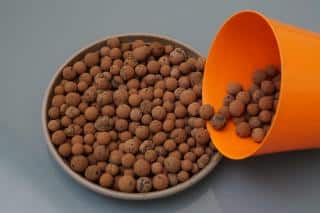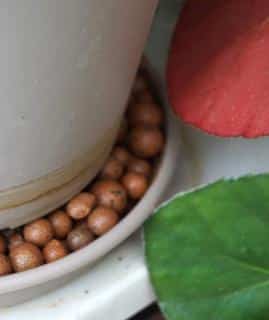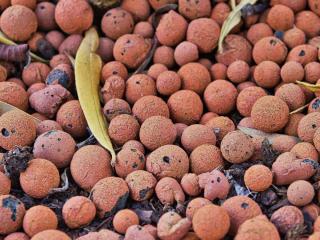

Air moisture is important for almost every houseplant, and clay pebbles can increase it for a very affordable price.
Clay balls & moisture facts
Time to set up – 5 minutes
Water fill-up – once/twice daily
Cost – a few cents
Effectiveness – high
A layer of expanded clay balls kept moist under your plant will work wonders. It will keep plants from getting brown tips on leaves!
 Set a tray filled with wet clay balls near or under your plant pots.
Set a tray filled with wet clay balls near or under your plant pots.
 You can rest all your pots atop such a tray. In no time, your plants will turn more lush and lively!
You can rest all your pots atop such a tray. In no time, your plants will turn more lush and lively!
Use rainwater for houseplants. If you haven’t collected rainwater yet, use demineralized water like the one used for ironing clothes.
The bubbles in the pebbles are perfect to absorb water and air. The thin clay walls are porous and let water seep in and out. The consequence? Expanded clay pellets make ideal air moisturizers thanks to their structure and materials.
Water will evaporate from the surface of the clay balls and enter the air around it. Thanks to capillarity, water deeper inside the clay ball will seep to the surface for evaporation to continue.
Clay pellets are always available in garden stores. They’re often used as a cool mineral mulch and as an additive to soil mix since they increase water retention and drainage.
After a few hours, most of the water will have evaporated already. At the end of the day, the clay pebbles will usually be totally dry.
For maximum air humidifier effect, replenish water on your clay pellets twice a day, morning and evening.
On hot days, a third top-up might be necessary in the afternoon.
If you notice pebbles are drying up very fast, you can also add a bit more water than necessary to let the pebbles wallow in a little water. For example, a quarter-inch or 5mm water level at the bottom will serve as a “water reserve”. The pebbles, like a wick, will draw moisture up from it during the day.
Another option is to find a glass or bottle that contains just enough volume to douse the pebbles well.
Remember to use distilled water or rainwater for this as much as you can. In fact, whatever technique you use to raise air humidity around plants, try to avoid tap water.
Monthly, replace and/or clean the pebbles to keep pests, algae and insects out.
If they’re very dirty:
 pour the expanded clay balls or pebbles in an old sock (or several) and tie it shut.
pour the expanded clay balls or pebbles in an old sock (or several) and tie it shut.Once clean, sterilize them in the following manner:
Plants that benefit most from this technique are those that tend to release lots of water to the air.
Minerals in tap water slowly clog pores over time. This means they can’t absorb water any more, losing effectiveness. They’ll still do the job, but no better than if you’d used regular gravel picked up from the ground or driveway.
If you don’t clean the pebbles from time to time, they’ll attract pests. These include red spider mite, thrips, scale insects and others.
Rest your pots atop clay balls to prevent root rot. The bottom of the pot is never in direct contact with wallowing water, protecting roots inside.